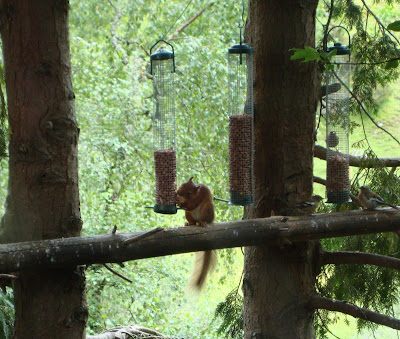I spent 15th to 25th September back in Portugal , based again at the wonderful Lagoon Cottage, enjoying ten days of sunshine (temperatures often around 30o) and lots of birds. It’s not easy to pick out highlights when everyday brought something special, but here goes...
The garden at Lagoon Cottage always has plenty of interesting birds but this time it was exceptional - along with the Sardinian Warblers, Azure-winged Magpies, Little Owls and Waxbills...
... we had juvenile Golden Oriole, Nightingale, Crested Tit, Short-toed Treecreeper, Spotted Flycatcher, Pied Flycatcher...
Whinchat...
and Willow Warbler...
It even produced another lifer for me – a Lesser Spotted Woodpecker. On a couple of occasions a pair were seen, but the male bird was particularly reliable, appearing several mornings, always around 7am, on his favourite sunlit tree. His appearances were usually brief but on one of the mornings Carolyn managed to get this photo...
Another creature that regularly appeared in the garden was this beautiful Hummingbird Hawkmoth...

And talking of beautiful creatures, we saw some stunning butterflies, including Swallowtail, Two-tailed Pasha...
and this Plain Tiger at Vilamoura...
Vilamoura is one of our favourite reserves and we were particularly pleased when we went there this time because a team of UK ringers were on site – giving us a chance to see a number of birds ‘in the hand’...
 |
| Melodious Warbler |
 |
Red-rumped Swallow
|
And my favourite... a Bluethroat.
Another memorable day was a pelagic out of Fuseta - a three hour boat trip during which we had close up views of Gannets, Great Skuas, Slender-billed Gull, Storm Petrel, Sooty Shearwater, Cory’s Shearwater and, best of all, several Great Shearwaters...
One of the main aims of the holiday was to see some raptor migration, so on three of the days we went to Cabranosa watch point near Sagres. Standing at the top of this scrub covered hill...
...you have a panoramic view all around and can never be sure what’s going to turn up. Each day is different. Our tally for the three visits included Booted Eagle [one day we had an estimated total of 250 flying over], Short-toed Eagle, Common Buzzard, Honey Buzzard [including some stunning pale phase birds], Goshawk, Griffon Vulture, Egyptian Vulture, Black Kite, Marsh Harrier, Kestrel and Sparrowhawk.
We had a spectacular view of a Short-toed Eagle away from Cabranosa - when we were driving home one day. It was distant when first spotted, but within minutes it was soaring effortlessly over us. I don’t have the photographic equipment necessary to take photos in that situation, but fortunately Malcolm does, and he has kindly let me use this one. Such an impressive bird...




















































